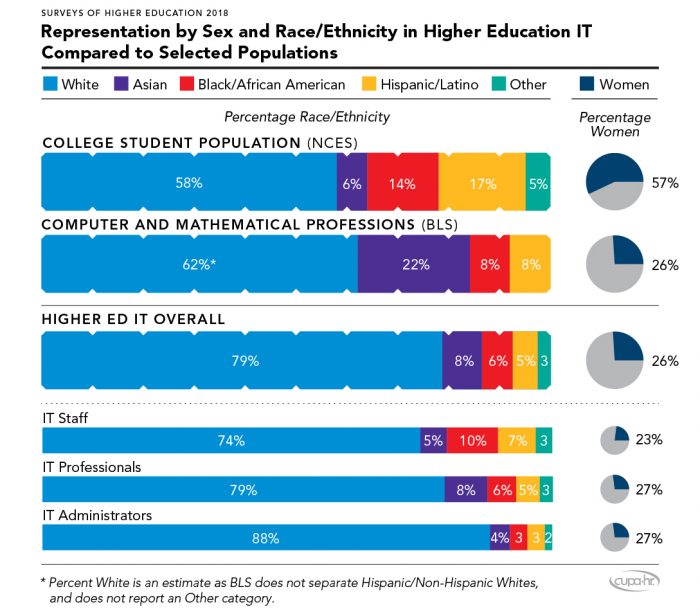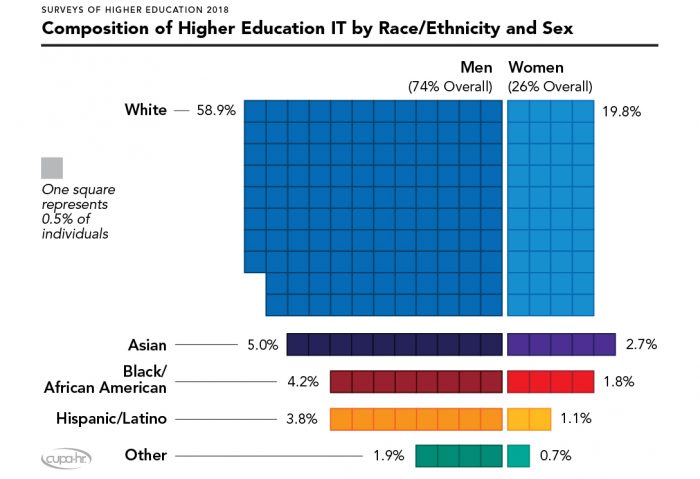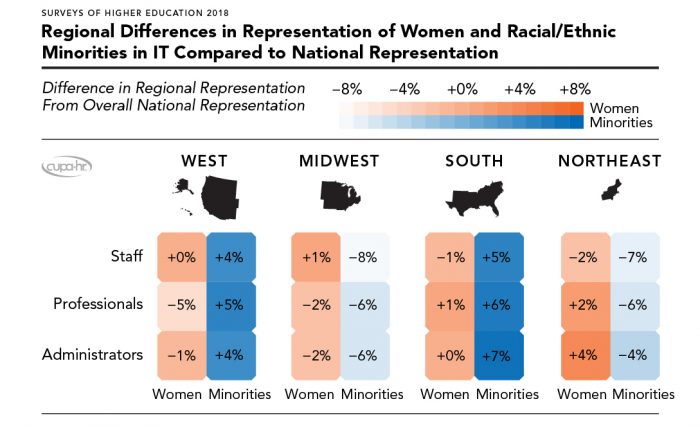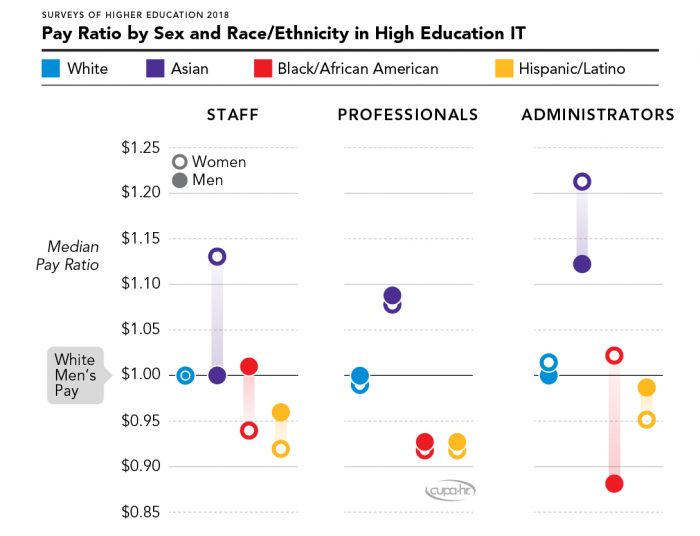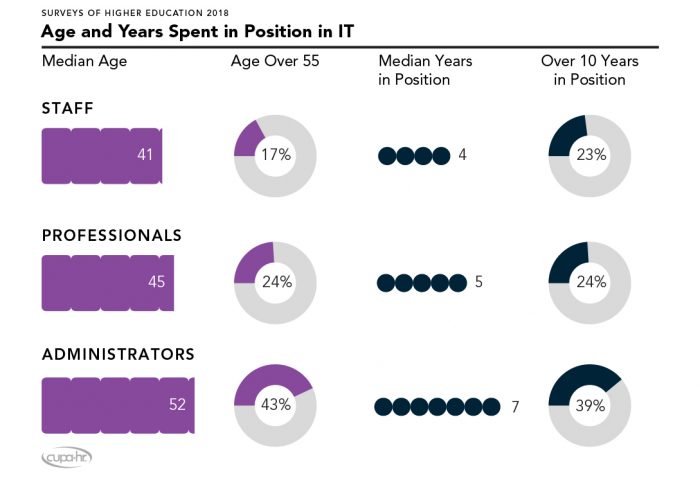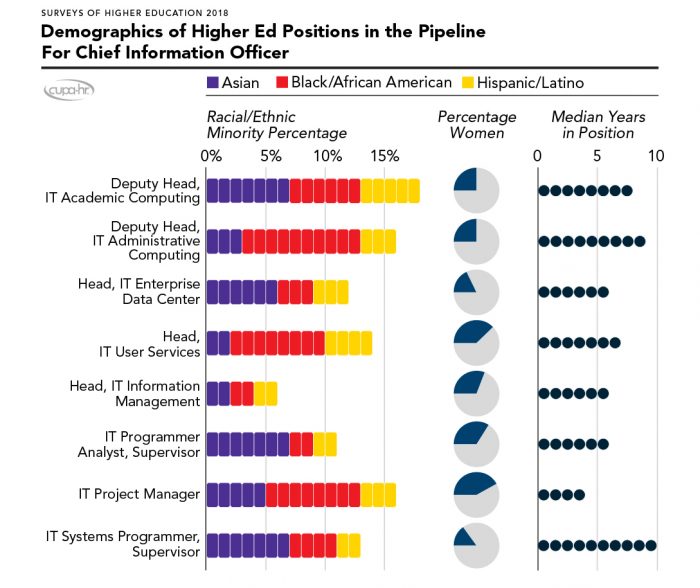Diversity in Higher Education Information Technology
By Adam Pritchard, Keith McIntosh, and Jasper McChesney | July 2019
Introduction
The information technology (IT) workforce serves many vital functions in higher education, supporting campus computing needs ranging from advanced research and business and administrative operations to student learning and technology needs. As IT becomes an increasingly important part of the success of higher education, it is equally important to understand factors that help promote and maintain the success of higher education’s IT workforce.
EDUCAUSE, the largest professional organization for higher education IT, has recognized that remedying higher education’s lag with respect to diversity, equity, and inclusion (DEI) in the IT workforce is a critical priority. EDUCAUSE has launched a CIO Commitment Statement, with 450 signatories thus far, demonstrating their support for DEI and holding themselves accountable for progress. The association has also created a DEI resource website and has completed a workforce study on DEI in higher ed IT.1Follow these links to read more about EDUCAUSE’s diversity efforts, including the CIO Commitment Statement, DEI resource website, and the IT workforce study.
Now, with the help of data from CUPA-HR, it is possible to examine in detail the demographic makeup of the higher education IT workforce, helping to better understand the workforce today and to identify opportunities in the pipeline for future higher education IT leaders.
This research brief provides a snapshot of diversity and pay equity in higher education IT, a look at the aging of IT administrators, and the characteristics of possible pipeline positions from data collected in the 2018 CUPA-HR Administrators in Higher Education, Professionals in Higher Education, and Staff in Higher Education surveys. In all, higher education institutions provided data for over 36,577 incumbents in 51 information technology positions for the 2017-18 academic year.2These data include salary and demographics for 1,784 administrators (eight positions); 30,159 professionals (37 positions); and 4,634 staff (four positions).
Table 1. Surveys of Higher Education 2018 IT Positions in Higher Education
Diversity and Pay Equity
Representation
Among higher education IT employees, 26% are women and 21% are racial/ethnic minorities. Representation by sex and race/ethnicity are presented in Figure 1.
Representation of women and racial/ethnic minorities in higher education IT is much lower than among college students, the primary constituent population they serve.3National Center for Education Statistics (2016). Table 306.10. Digest of Education Statistics. When compared to math and computer occupations more broadly, higher education IT has comparable representation of women, but lower racial/ethnic representation.4Bureau of Labor Statistics (2018). Table 11. Employed persons by detailed occupation, sex, race, and Hispanic or Latino ethnicity. Labor Force Statistics From the Current Population Survey.
The representation of minorities varies greatly within higher education IT, with far more minorities represented in staff and professional positions than in administrator roles.
Figure 1. Representation by Sex and Race/Ethnicity in Higher Education IT Compared to Selected Populations
Figure 2 shows the composition of all higher education IT employees broken down by sex and race/ethnicity. White men make up the majority (59%) of higher education IT employees, and about 70% of minorities in higher ed IT positions are men. Black and Hispanic women are the least-represented groups in higher ed IT, together occupying only about 3% of all IT positions (and only 0.5% of all IT administrative positions).
Given the diversity of the college student and computer and math occupations populations shown in Figure 2, there is much room for improvement in higher education IT.
Figure 2. Composition of Higher Education IT by Race/Ethnicity and Sex
Diversity Across the Country
One pathway to increasing the diversity of higher education may be for institutions to recruit experienced individuals from regions of the country with better representation of women and racial/ethnic minorities. Figure 3 shows how much representation in higher education IT within each U.S. Census region varies from the national average.5Use DataOnDemand for custom comparison groups of geographic or institutional characteristics.
Female IT professionals and administrators are better represented in the Northeast than in the rest of the country, whereas minorities are much better represented in the South and West. This data highlights the need for considering nationwide or regionally-targeted recruiting strategies when seeking diverse candidates — particularly for leadership roles.
Figure 3. Regional Differences in Representation of Women and Racial/Ethnic Minorities in IT Compared to National Representation
Pay Equity
Whether or not women or minorities are paid equitably varies by both racial/ethnic background and job level. Figure 4 shows pay ratios by sex and race/ethnicity, using the median salaries paid to White males as the baseline. In general, Black and Hispanic women are underpaid relative to their White male peers, White women are paid equitably, and Asians are generally paid more than White men.
Figure 4. Pay Ratio by Sex and Race/Ethnicity in Higher Education IT
Aging, Retirement, and the Pipeline
An important concern for many U.S. employers is the expected wave of retirements in leadership positions as the last of the baby boomers (born between 1946 and 1964) turns 55 years old in 2019, with many already at or past the expected retirement age. Administrators in higher education IT are no exception. For higher ed IT, this demographic transition may present an opportunity to make progress on diversity as this less-diverse generation gives way to a younger, more diverse generation.6U.S. Census Bureau (2015, June 25). Millennials Outnumber Baby Boomers and Are Far More Diverse, Census Bureau Reports. (Press Release).
Long-Serving Administrative Leadership
The median age of the IT administrators highlighted in this report is 52 years old; however, the proportion of higher education IT employees that are older suggests that higher education IT may soon face succession planning challenges.
Around 43% of IT administrators are over 55 years old (Figure 5). The median years in position is seven, but almost 39% of higher education IT administrators have more than 10 years in their current role. This is high compared to all administrators in higher education, where the median time in position is five years, and only 25% of administrators have more than 10 years in their current position.
Figure 5. Age and Years Spent in Position in IT
Diversity in the Pipeline
Certain IT positions are considered part of the pipeline to administrative leadership roles. Figure 6 highlights key demographics for eight such positions from the
CUPA-HR Professionals in Higher Education Survey. Some of these positions have higher representation than average for women or individuals from certain racial/ethnic groups, and therefore may provide opportunities to recruit diverse future leaders as older employees near retirement.
Some in higher education IT have argued that to close the gap on diversity in the field, a different way of thinking about recruitment, retention, and creating inclusive environments may be necessary, including deliberate efforts to use this type of data to recruit more diverse leaders.7McIntosh, K.; Pomerantz, J.; Rodrigues, H.; Smith, C.; & Woo, M. (2017, June 5). Expanding Your Recruitment Pool Through Increasing Diversity, Equity, and Inclusion. EDUCAUSE Review. Higher education IT may also need to consider recruiting diverse candidates for leadership roles from outside of higher education or from positions not typically identified as part of traditional job progressions.
Figure 6. Demographics of Higher Ed Positions in the Pipeline for Chief Information Officer
Conclusions and Next Steps
CUPA-HR data on information technology positions in higher education can help institutions focus their attention on key aspects of diversity for this critical part of the higher ed workforce:
- Information technology is an overwhelmingly White (81%) and male (74%) field. Intersectional diversity is extremely limited; for instance, only 3% of IT administrators are minority females.
- Minority representation in IT positions is higher in some parts of the U.S. than others, specifically the South and West.
- Despite much lower representation, pay among women and minorities is frequently close or comparable to salaries paid to White men, although large differences occur in certain types of roles (e.g., Black male administrators earn $0.88 per $1; Asians earn as much as $1.21 per $1).
- Around 43% of IT administrators in higher education are over 55 years old, and 39% of IT administrators have been in their current role for more than 10 years. The time to begin succession planning is now — and the data show that certain positions in the immediate higher education IT pipeline may present opportunities to improve DEI in the process.
The data in this brief highlight the need for higher education IT to address the critical issues of improving DEI and, at the same time, plan for the future of leadership — two goals that are not necessarily unrelated. Here are a few helpful resources to get your institution started:
CUPA-HR Diversity Resources
Resources from CUPA-HR are a great place to start when seeking action-oriented information on diversity, equity, and inclusion. Begin with the DEI Maturity Index that lets you self-evaluate your DEI efforts, giving you a score and action steps to improve it. Learn from the Creating Inclusive Communities project and from DEI-specific individual and group courses how to initiate a conversation about DEI on your campus. Finally, access resources and toolkits to help you implement changes.
CUPA-HR Knowledge Center
A resource for CUPA-HR members (requires login), the Knowledge Center contains toolkits on various HR topics, including the Leadership & Strategy toolkit that contains resources on succession planning. Use these practical tips and tools to ensure that your institution is ready for the future.
EDUCAUSE CIO Commitment
As the largest association for IT professionals in higher education, EDUCAUSE continues to lead the charge for diversity, equity, and inclusion in higher ed IT by encouraging chief information officers (CIOs) to make a public commitment to promoting DEI on their campuses. Is your CIO ready to make this commitment? If so, join the community and access helpful information and resources to make good on this commitment.
EDUCAUSE Diversity, Equity, and Inclusion Resources
Additional resources from EDUCAUSE to promote DEI, including its workforce study.
Citation for this report: Pritchard, Adam; McIntosh, Keith; & McChesney, Jasper (2019, July). Diversity in Higher Education Information Technology: From Today’s Workforce to Tomorrow’s Leaders (Research Report). CUPA-HR.
Printer-friendly Version 1 Follow these links to read more about EDUCAUSE’s diversity efforts, including the CIO Commitment Statement, DEI resource website, and the IT workforce study.
 2 These data include salary and demographics for 1,784 administrators (eight positions); 30,159 professionals (37 positions); and 4,634 staff (four positions).
2 These data include salary and demographics for 1,784 administrators (eight positions); 30,159 professionals (37 positions); and 4,634 staff (four positions).
 3 National Center for Education Statistics (2016). Table 306.10. Digest of Education Statistics.
3 National Center for Education Statistics (2016). Table 306.10. Digest of Education Statistics.
 4 Bureau of Labor Statistics (2018). Table 11. Employed persons by detailed occupation, sex, race, and Hispanic or Latino ethnicity. Labor Force Statistics From the Current Population Survey.
4 Bureau of Labor Statistics (2018). Table 11. Employed persons by detailed occupation, sex, race, and Hispanic or Latino ethnicity. Labor Force Statistics From the Current Population Survey.
 5 Use DataOnDemand for custom comparison groups of geographic or institutional characteristics.
5 Use DataOnDemand for custom comparison groups of geographic or institutional characteristics.
 6 U.S. Census Bureau (2015, June 25). Millennials Outnumber Baby Boomers and Are Far More Diverse, Census Bureau Reports. (Press Release).
6 U.S. Census Bureau (2015, June 25). Millennials Outnumber Baby Boomers and Are Far More Diverse, Census Bureau Reports. (Press Release).
 7 McIntosh, K.; Pomerantz, J.; Rodrigues, H.; Smith, C.; & Woo, M. (2017, June 5). Expanding Your Recruitment Pool Through Increasing Diversity, Equity, and Inclusion. EDUCAUSE Review.
7 McIntosh, K.; Pomerantz, J.; Rodrigues, H.; Smith, C.; & Woo, M. (2017, June 5). Expanding Your Recruitment Pool Through Increasing Diversity, Equity, and Inclusion. EDUCAUSE Review.





